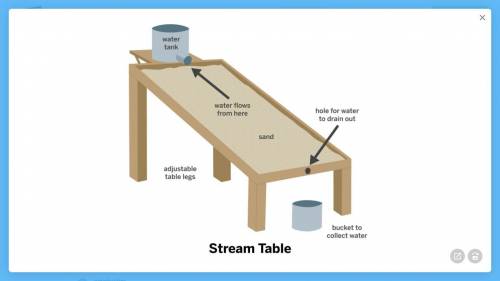
Chemistry, 20.11.2020 01:40 allieeastridge
Using Models to Answer Questions About Systems
Armando’s class was looking at images of rivers formed by flowing water. Most of the rivers were wide and shallow, but one river was narrow and deep.
Help Pls
Armando’s class thinks that this river is narrow and deep because:
the hill that the water flowed down was very steep, or
the sand grains that the water flowed through were very small.
Armando designed the model below to try to answer the question: Why is this river so narrow and deep?
1a. What features of this model will help Armando answer the question?
1b. How could Armando use this model to test the idea that very steep hills lead to narrow, deep rivers?
1c. How could Armando use this model to test the idea that very small sand grains lead to narrow, deep rivers?
2. Armando thinks that it is the very steep hill that makes this river narrow and deep, but his classmate thinks it is the small size of the sand grains that the water flows through. What results from the model would be evidence that Armando’s idea is correct?


Answers: 3


Another question on Chemistry

Chemistry, 22.06.2019 05:30
What type of reaction is shown below? check all that apply. 2h2o2 → 2h2o + o2 synthesis decomposition combustion
Answers: 3

Chemistry, 22.06.2019 06:00
24. a sports ball is inflated to an internal pressure of 1.85 atm at room temperature (25 °c). if the ball is then played with outside where the temperature is 7.5 °c, what will be the new pressure of the ball? assume the ball does not change in volume nor does any air leak from the ball a) 0.555 atm b) 1.74 atm c) 1.85 atm d) 1.97 atm
Answers: 2

Chemistry, 22.06.2019 09:00
What type of energy do chemical bonds have? what type of energy is it converted to during chemical reactions? question 15 options: chemical bonds have kinetic energy, which is converted to potential energy during chemical reactions. chemical bonds have electric energy, which is converted to potential energy during chemical reactions. chemical bonds have heat energy, which is converted to kinetic energy during chemical reactions. chemical bonds have potential energy, which is converted to heat energy during chemical reactions.
Answers: 1

Chemistry, 22.06.2019 12:00
Ineed this asap part i: scientific method what is the difference between science and pseudoscience? what is the scientific method?
Answers: 2
You know the right answer?
Using Models to Answer Questions About Systems
Armando’s class was looking at images of rivers form...
Questions



Social Studies, 21.04.2021 01:50



Mathematics, 21.04.2021 02:00

Mathematics, 21.04.2021 02:00



Mathematics, 21.04.2021 02:00

English, 21.04.2021 02:00

Mathematics, 21.04.2021 02:00

Chemistry, 21.04.2021 02:00




Mathematics, 21.04.2021 02:00


Mathematics, 21.04.2021 02:00



